ASUS N53JF: Midrange 15.6” 1080p, Take Four
by Jarred Walton on December 28, 2010 1:40 AM ESTGaming Performance
We’ve covered this ground several times of late: 1080p with “midrange” mobile graphics really isn’t great for playing games, but at least you can turn down the resolution to get reasonable performance. We’ve run our Low, Medium, and High benchmarks at both the standardized resolutions as well as 1080p, but you’ll generally want to stick to medium quality or lower if you want to run at native resolution.

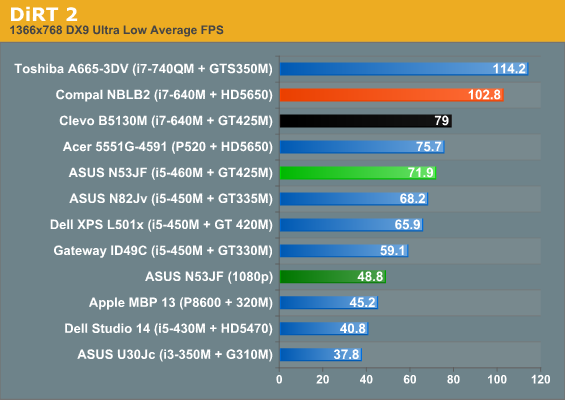
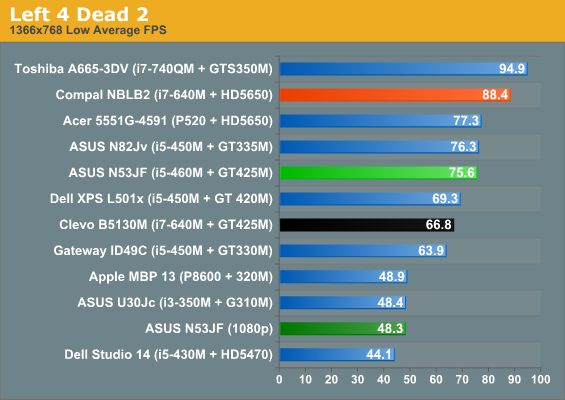
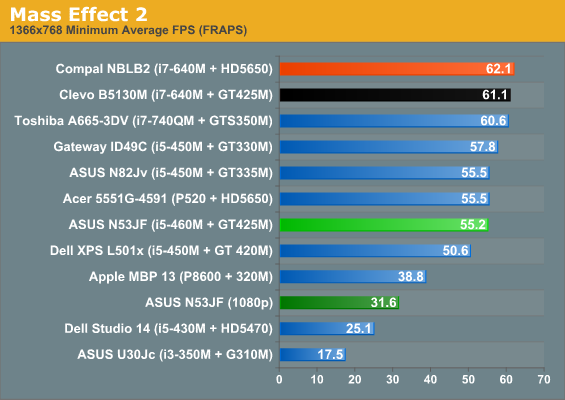


Starting at Low detail, about the only thing worth noting (other than the games all being playable) is that several titles benefit from the faster CPU in the Clevo notebook, but BFBC2, L4D2, and STALKER all give the ASUS a slight lead, with a larger 13% lead in L4D2. The Clevo notebook clocked the GPU the same, but used 1400MHz memory instead of 1600MHz RAM for graphics, so that 14% deficit shows up in some games more than others. Again, we ran Mafia 2 and Metro 2033 but are skipping the graphs for the time being. Mafia 2 manages 35FPS at 768p and 21.5FPS at 1080p, so it manages low detail and low resolution at least. Metro 2033 doesn’t even clear the 30FPS hurdle at 768p, scoring 26FPS and dropping into the teens (17FPS) at 1080p. The scores are basically right where we’d expect given the GPU and CPU.

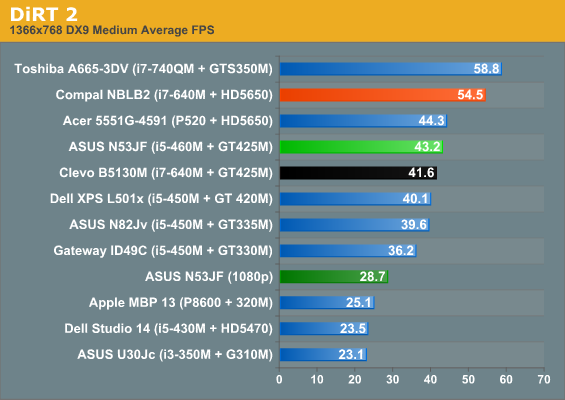


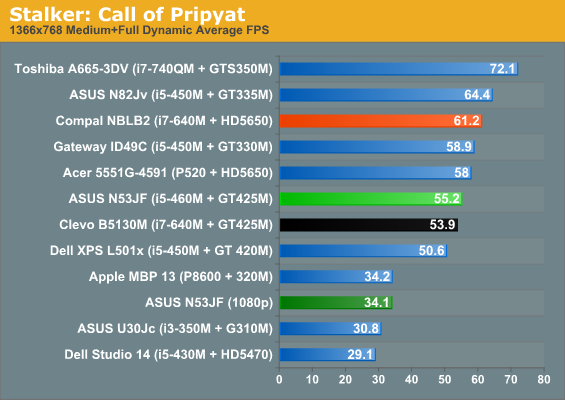
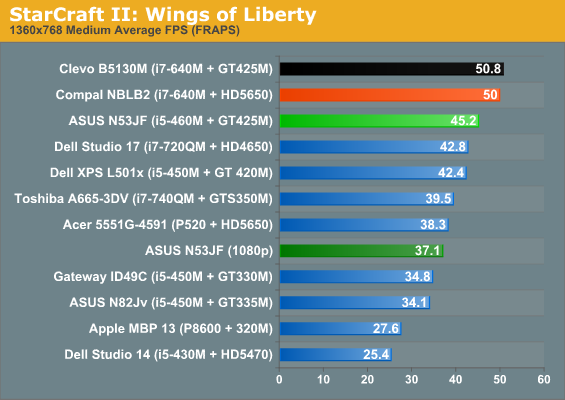
The story is similar at medium detail, and again the ASUS notebook leads the Clevo, this time in four out of six games. The lower memory bandwidth is definitely a factor here, though the difference isn’t so large as to be alarming and the faster CPU still pushes Clevo ahead in Mass Effect 2 and StarCraft II. 1080p with medium is only playable in STALKER and SC2, while the other titles will need to drop to a lower resolution. Mafia II and Metro 2033 continue their slide into unplayable territory, with scores of 30.4/18.1 and 24.4/16.1 respectively (at 768p/1080p). As mentioned in the Compal review, AMD’s HD 5650 also manages to lead the 420M/425M at our Medium settings in virtually every case, despite being six months older hardware.
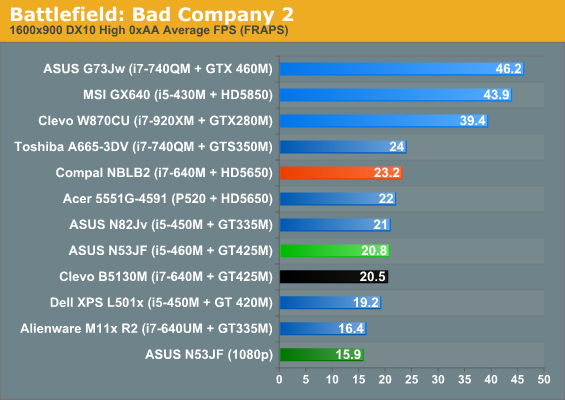
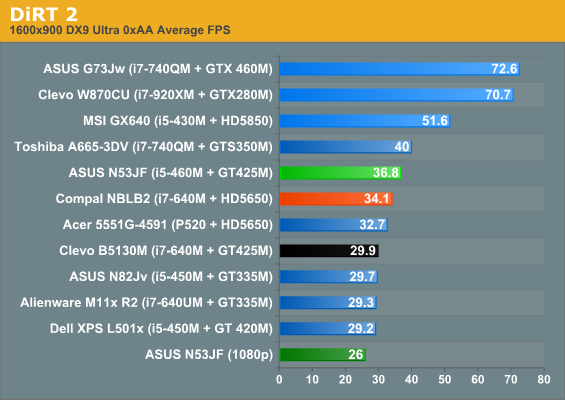
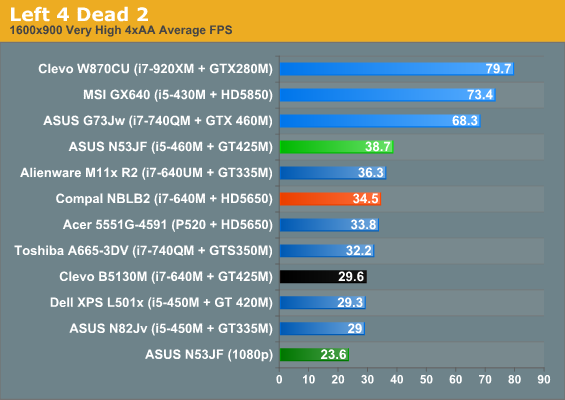
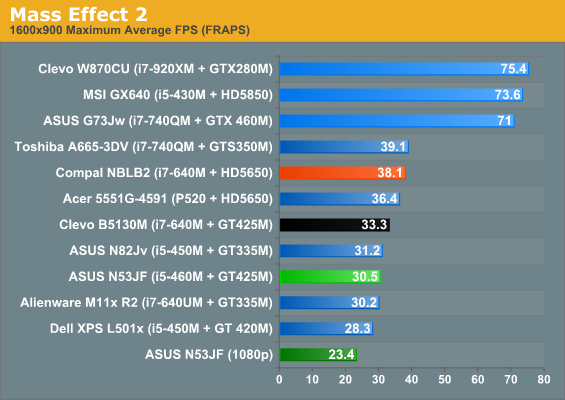


Finally, our High settings push many of the titles below 30FPS, though DiRT 2, L4D2, and ME2 all manage 900p High at >30FPS. As for Mafia II and Metro, they’re now down to 23.6/17.6 and 14.6/11.3 for 900p/1080p, which definitely isn’t playable. Also worth noting is that we continue to test games in DX9 or DX10 modes rather than DX11, as performance drops in nearly every DX11-enabled title and mobile GPUs aren’t usually fast enough to have the luxury of increasing detail levels. DiRT 2 is the odd man out, boasting higher performance at Ultra Low through Medium detail when DX11 is enabled, but the tables turn at the Ultra High setting. What we really need to make DX11 and high quality settings viable for notebooks is about twice the current level of performance—roughly equal to the HD 5850 or GTX 460M. “Midrange” laptops still require you to drop to lower resolutions, lower details settings, or both.










65 Comments
View All Comments
anactoraaron - Tuesday, December 28, 2010 - link
That they would pack in USB 3.0, bluray and then put in that below average 1080p display. Not that it matters with Sandy Bridge on the horizon. Best advise is still to wait.ET - Tuesday, December 28, 2010 - link
It's nice to see 1080p becoming more prevalent at this size laptop, but why can't we see some higher res displays at 20"+? I had a 19" 1600x1200 CRT eight years ago, and resolution hasn't gone up since then, and even dropped from 1920x1200 to 1080p in recent times. Laptops these days have some high DPI displays and I'd love to see some on the desktop.Ushio01 - Tuesday, December 28, 2010 - link
1920x1080 monitors are replacing 1680x1050 TN panels in the mid range monitor segment just as 1680x1050 replaced 1280x1024 monitors with the advantage of either 120hz TN or IPS screens. 1920x1200 monitors still exist and are just as expensive as always along with the 2560x1440 and 2560x1600 in the high and very high end segments.jabber - Tuesday, December 28, 2010 - link
1080p will be a curse for us all in a couple of years time.Never will a standard have been surpassed and found wanting so quickly.
They should have made it 1440p at least.
Now us computers users have to suffer from the display world being lazy and sticking to a screen depth not much more that what we were used to 10 years ago.
Thats progress.
DanNeely - Tuesday, December 28, 2010 - link
I think the main bottleneck for the resolution picked for the HD standard was the capacity of dtv broadcast/blueray/hddvd disks without any compression artifacts. Bumping the frame sizes up 77% would have needed a significantly higher compression level and would've resulted in the videophiles who're currently reviling netflix/hulu/etc's streaming offerings for low quality to have slammed the new standards; potentially rendering them stillborn at birth, and almost certainly slowing adoption down significantly.The other hangup would be the size of the TV screen needed to get full use of the resolution in the living room. 1080p is generally not worthwhile on less than a 40" screen because the angular size of the pixels at 720p are too small to resolve at couch distance. The smaller pixels of a 1080p screen won't be visible as individual pixels until about 56". At the time the standards were being written 56" was an enormously large TV. It's still larger than most TVs sold today.
Until that changes (and bluerays, or the bandwidth needed to stream them at full quality, become commodity items) I don't expect anything to change on the consumer video market. When that happens I expect the new standard will be one of the 4k resolutions; probably either 3996×2160 (1.85:1) or 4096×1714 (2.39:1). We'd also need a higher density video cable standard. DP 1.2 will carry the 2d version of either signal, but would need doubled again to support 3d. Hopefully lightpeak will be mainstream by then and able to carry the data.
TegiriNenashi - Tuesday, December 28, 2010 - link
2.39:1 ? That is insane.DanNeely - Tuesday, December 28, 2010 - link
It's the wide-wide screen mode at theaters today. IT would render all but the largest desktop computer displays too short to be useful for anything except consuming content. The video industry would see this as a feature.TegiriNenashi - Tuesday, December 28, 2010 - link
I don't think letterbox has any future in the movie industry itself. Avatar 3D was rendered at 1.78 : 1. Let the 2.39:1 die, the sooner the better!Hrel - Tuesday, December 28, 2010 - link
here hereJarredWalton - Tuesday, December 28, 2010 - link
Hear, hear?